William apprentice John Kerley Wtby
- John Kerley b. Kent 1827
- John Kerley local ME preacher m. to Mariette S Grant b 1832 d/o Joel Marshall Grant and Jeanette Greeley Grant
- From The history and genealogies of ancient Windsor, Connecticut: including East ... By Henry Reed Stiles
- 855. MARIETTA SOPHIA11 GRANT (JOEL MARSHALL10, MOSES9, ELIJAH8, JOSIAH7, JOHN6, MATTHEW5, JOHN4, GEORGE3, JOHN2, WILLIAM1) was born July 06, 1832 in Chautauqua, NY. She married JOHN KERLEY December 31, 1850 in Seymour, CT, son of HOSEA KERLEY and MARIA BEECHER. He was born November 30, 1827 in Kent, CT.
Notes for JOHN KERLEY:
res. New Haven (514 George St.); form. Waterbury; merchant; form. contractor and builder; 9 yrs. with the Waterbury Clock Co.,; M.E. local preacher
http://familytreemaker.genealogy.com/users/g/r/a/Charles-Loring-Grant/GENE10-0113.html
-
Waterbury Clock Company History
http://www.clockguy.com/SiteRelated/SiteReferencePages/WaterburyHistory.html |
|
Formed March 5, 1857, as a joint stock corporation, the Waterbury Clock Company from its inception was an operation designed to be a major user of brass produced by the parent firm, the Benedict & Burnham Manufacturing Company. Utilizing the best talent available to them, they hired veteran clockmaker Chauncey Jerome to set up the new firm's casemaking shop and his brother Noble Jerome, a well-known clock mechanic, to set up the movement manufacturing operation.
Though this firm became a major clock producer, after 1890 they became a major manufacturer of non-jeweled pocket watches, supplying R. H. Ingersoll & Brother, a major mail order firm. Large-scale production and profitability were enjoyed for more than two decades with this association. Major factory expansions between 1900 and 1915 made this the largest clock manufacturing facility in America. |
|
- =======================
- ID: I21058
- Name: John KERLEY
- Birth: 30 NOV 1827 in Kent, Litchfield, CT
- Occupation: grain dealer
- Note: Household Record 1880 United States Census
Name Relation Marital Status Gender Race Age Birthplace Occupation Father's Birthplace Mother's Birthplace
John KERLEY Self M Male W 52 CT Grain Dealer VA CT
Marriett S. KERLEY Wife M Female W 46 NY Keeps House CT CT
Mary A. GRANT SisterL S Female W 44 NY Artist, Portrait Painter CT CT
Chas B. MERRILL Nephew S Male W 24 CT Ck. Fruit & Butter CT CT
Census Place New Haven, New Haven, Connecticut
Family History Library Film 1254106
NA Film Number T9-0106
Page Number 282A
Father: Hosea Rowe KERLEY b: 1802 in CT
Mother: Mariah (Mary) BEECHER b: JUN 1806 in CT
Marriage 1 Marietta Sophia GRANT b: 6 JUL 1832 in Chautauqua, Chautauqua, NY
- Married: 31 DEC 1850 in Seymour, New Haven, CT
- Children
- Giles Phelps KERLEY b: 16 OCT 1851 in Waterbury, New Haven, CT
- George Grant KERLEY b: 14 JUL 1855 in Waterbury, New Haven, CT
John Kerley 1860 Waterbury Clockmaker age 31& margaret age 27 next to Ralph Jennings 28 & Frances J
Jennings 27
John Kerley 1870 Waterbury Grocer age 42 and Marietta 35 also Mary A. Grant 33 Ornamental Painter
John Kerley
1880 New Haven age 52 grain dealer with Marietta age 46 Mary A, Grant & Chas Merrill nephew, on Broadway
grandmother findagrave
Polly Jennings
. Birth: 1797 Death: May 20, 1881 Litchfield County Connecticut, USA Jennings, Polly, wife of John, died May 20, 1881, age 84 Burial: Milton Cemetery Litchfield Litchfield County Connecticut, USA Created by: Linda Mac Record added: Sep 17, 2009 Find A Grave Memorial# 42064588
grandfather
- maybe not kerley connection directly, but neighbor of family
| John Jennings |
| Birth: |
1796 |
| Death: |
Dec. 10, 1879
Litchfield County
Connecticut, USA |

Jennings, John, died Dec. 10, 1879, age 83
|
| |
Burial:
Milton Cemetery
Litchfield
Litchfield County
Connecticut, USA |
Created by: Linda Mac
Record added: Sep 17, 2009
Find A Grave Memorial# 42064743 |
|
|
could he be earlier son/marriage of
- ID: I353810
- Name: Lemuel Jennings
- Given Name: Lemuel
- Surname: Jennings 1 2 3
- Sex: M
- Birth: 13 Nov 1772 in Fairfield, Fairfield County, Connecticut, USA 3
- Death: 16 Jun 1845 in Newtown, Fairfield County, Connecticut, USA 4 3
Father: Abraham Jennings b: 1750 in Fairfield, Fairfield County, Connecticut, USA
Mother: Charity Risden b: 1743 in (Stratfield or Stratford), Fairfield County, Connecticut, USA
Marriage 1 Polly Fairchild b: 1770 in Bridgewater, Litchfield County, Connecticut, USAMarried: 14 Mar 1799 in Bridgewater, Litchfield County, Connecticut, USA 5
| |
A fairfield cousin but pretty distant. With the Stratford connection, I wonder if there is a Methodist connection?
Otherwise, the Grant or Methodist connection may be more important |
| |
Abraham Jennings (Zachariah Jennings5, John Jennings4, Joseph Jennings3, Joshua Jennings2, John Jennings1) was born 1750 in Fairfield, Fairfield County, Connecticut, USA, and died 7 Feb 1838 in Weston, Fairfield County, Connecticut, USA. He married Charity Risden 2 Jul 1772 in Weston, Fairfield County, Connecticut, USA, daughter of Nathaniel Risden and Charity Hall. She was born 1743 in (Stratfield or Stratford), Fairfield County, Connecticut, USA, and died 13 Jul 1847 in Trumbull, Fairfield County, Connecticut, USA. |
|
Children of Abraham Jennings and Charity Risden are:
| + |
19 |
i. |
Lemuel Jennings was born 13 Nov 1772 in Fairfield, Fairfield County, Connecticut, USA, and died 16 Jun 1845 in Newtown, Fairfield County, Connecticut, USA. |
| |
20 |
ii. |
Rhoda Jennings was born 24 Jul 1775 in Weston, Fairfield County, Connecticut, USA, and died 31 Dec 1832 in Easton, Fairfield County, Connecticut, USA. |
| |
21 |
iii. |
Elijah Jennings was born 26 Aug 1777 in Weston, Fairfield County, Connecticut, USA, and died 6 Jun 1794 in Easton, Fairfield County, Connecticut, USA. |
| |
22 |
iv. |
Ruth Jennings was born 13 Apr 1780 in Weston, Fairfield County, Connecticut, USA. |
| |
23 |
v. |
Joseph Jennings was born 15 Apr 1782 in Weston, Fairfield County, Connecticut, USA. |
| |
24 |
vi. |
Esther Jennings was born 11 May 1785 in Weston, Fairfield County, Connecticut, USA, and died 3 Feb 1864 in Trumbull, Fairfield County, Connecticut, USA. |
| |
25 |
vii. |
Levi Jennings was born 10 Apr 1788 in Weston, Fairfield County, Connecticut, USA. |
| |
26 |
viii. |
Charity Jennings was born 3 Jul 1790 in Weston, Fairfield County, Connecticut, USA, and died 9 Jan 1794 in Weston, Fairfield County, Connecticut, USA. |
| |
27 |
ix. |
Sarah Jennings was born 27 Apr 1793 in Weston, Fairfield County, Connecticut, USA. |
| |
28 |
x. |
Polly Jennings was born 12 Jun 1797 in Weston, Fairfield County, Connecticut, USA. |
|
|
relations of John Addison Heacock
Entries: 247623 Updated: 2012-07-05 16:50:02 UTC (Thu) Contact: Thomas Koch 
maybe older bro of Abigail jennings Alvord?? NO
Joe's Genes
Entries: 38101 Updated: 2010-04-14 20:35:11 UTC (Wed) Contact: Joe Travis  Home Page: The OTHER "Joe's Genes" Home Page: The OTHER "Joe's Genes"
WARNING! - I am not a real 'genealogist'. Consider all information provided here as 'speculative' - merely a potential starting place for your own 'direct research'. If you find errors, or can offer additional information - please contact me.
Chauncey Jerome
From Wikipedia, the free encyclopedia
Chauncey Jerome (1793–1868) was a Clockmaker in the early 19th century. He made a fortune selling his clocks, and his business became enormous. He was born in Canaan in 1793; Chauncey Jerome was the son of a blacksmith and nail-maker.
Jerome began his career in Waterbury, making dials for long-case clocks. Jerome learned what he could about clocks, particularly clock cases, and then went to New Jersey to make seven-foot cases for clocks.
In 1816 he went to work for Eli Terry making "Patent Shelf Clocks," learning how to make previously handmade cases using machinery. Deciding to go into business for himself, Jerome began to make cases, trading them to Terry for wooden movements.
In 1822 Jerome moved his business to Bristol, opening a small shop with his brother Noble, producing 30 hour and eight-day wooden clocks. The company installed the first circular saw ever seen in Bristol.
By 1837 Jerome's company was selling more clocks than any of his competitors. A one-day wood-cased clock, which sold for six dollars, had helped put the company on the map. A year later his company was selling that same clock for four dollars.
The company sold one line of clocks at a wholesale price of 75 cents.
By 1841 the company was showing an annual profit of a whopping $35,000, primarily from the sale of brass movements.

A 19th-century Chauncey Jerome clock
In 1842 Jerome moved his clock-case manufacturing operation to St. John Street in New Haven. Three years later, following a fire that destroyed the Bristol plant, Jerome relocated the entire operation to the Elm City. Enlarging the plant, the company soon became the largest industrial employer in the city, producing 150,000 clocks annually.
Because of his discovery of a method of stamping rather than using casting gears, Jerome was producing the lowest-priced clocks in the world at the time.
In 1850 Jerome formed the Jerome Manufacturing Co. as a joint-stock company with Benedict & Burnham, brass manufacturers of Waterbury. In 1853 the company became known as the New Haven Clock Co., producing 444,000 clocks and timepieces annually.
Jerome's future should have been secure but in 1855 he bought out a failed Bridgeport clock company controlled by P.T. Barnum, which wiped him out financially, leaving the Jerome Manufacturing Co. bankrupt. Jerome never recovered from the loss. By his own admission, he was a better inventor than businessman.
Traveling from town to town, Jerome took jobs where he could, often working for clock companies that had learned the business of clock making using Jerome's inventions. Returning to New Haven near the end of his life, he died, penniless, in 1868 at age 74.
Nevertheless, Jerome had made a historic contribution to his industry when he substituted brass works for wooden works, said to be "the greatest and most far-reaching contribution to the clock industry."
He made, and lost, a fortune selling his clocks and was perhaps the most influential and creative person associated with the American clock business during the mid-19th century. In addition he served as a legislator in 1834, a Presidential elector in 1852 and mayor of New Haven from 1854 to 1855.
Always humble, of his own life he wrote: "The ticking of a clock is music to me, and although many of my experiences as a business man have been trying and bitter, I have satisfaction of knowing that I have lived the life of an honest man, and have been of some use to my fellow men."
Early life[edit]
Jerome was born in Canaan CT, and later moved to Plymouth Ct, where his father started a blacksmith shop. Jerome was a young boy when his father died, on October 5, 1804, and was forced to work in apprenticeship with salesmen. In one event, when walking around Bethlehem CT, to get to Torrington with his master, he noted how close he was to his mother in Plymouth, that night he made a run for it, running about twenty miles through woods, properties, farms, and in one case chased by dogs for a few miles, finally met his mother the next morning in Plymouth, the moment he contacted her, he realized it was morning and had to leave. He was victim of war at New Haven Fort, and when finished, he moved to Bristol to start apprenticeship with Eli Terry.
Brave ideas, and the Journey to England[edit]
Jerome started manufacturing in Bristol off of West Street. He took note of all of the men who laughed at "Mr. Terry" for Terry's foolish ideas of selling a clock for a minor $14. Jerome came up with the idea of a rectangular shelf clock, brass in method, and sell-able for $1, the OG clock. Jerome sent his son, and a peddler who was a great friend of Jerome to England to sell his one dollar OG clocks. Several months went by, as store owners in England refused to buy Jerome's clocks. The shop owners understood that Eli Terry's pillar and scroll clocks were "garbage" and never worked (because wooden gears warp over seas, causing poor time keepers). Finally Jerome's son got a man to buy a clock for one dollar, and put it on a shelf- the next day, an English man walked in and saw it was still working, and proudly purchased the clock, this started a chain reaction, and the shop owner purchased 100 more clocks on the spot. Jerome's friend who supervised his son fell ill of the plague, and died in England,followed by his son three months later.
References[edit]
External links[edit]
Categories:
http://en.wikipedia.org/wiki/Chauncey_Jerome
|
Life of CHAUNCEY JEROME,
WRITTEN BY HIMSELF.
BARNUM'S CONNECTION
WITH THE
YANKEE CLOCK BUSINESS.
New Haven: 1860 |
maybe but does not match all dara
Robert Meeker Descendants
Entries: 2731 Updated: Wed Apr 17 12:20:06 2002 Contact: Andrea Meeker 
Descendant Register, Generation No. 1
| 1. |
John Morehouse JENNINGS (John Benjamin (Burr) JENNINGS1) was born 1798, and died 1883. He married Ann BURR 1831. She was born 1804 in Westport, Fairfield, CT, and died 1890. |
|
Children of John Morehouse JENNINGS and Ann BURR are:
|
Descendant Register, Generation No. 2
| 2. |
Mary JENNINGS (John Morehouse JENNINGS2, John Benjamin (Burr) JENNINGS1) was born 1832. She married Nelson ALVORD 1853. He was born 1828, and died 1910. |
|
Child of Mary JENNINGS and Nelson ALVORD is:
|
| 4. |
Emily JENNINGS (John Morehouse JENNINGS2, John Benjamin (Burr) JENNINGS1) was born 1844. She married Ebenezer BEERS 1870. He was born 1839, and died 1896. |
|
Child of Emily JENNINGS and Ebenezer BEERS is:
|
Descendant Register, Generation No. 3
| 5. |
Harriet Anne ALVORD (Mary JENNINGS3, John Morehouse JENNINGS2, John Benjamin (Burr) JENNINGS1) was born 1854, and died 1887. She married Robert Thomas LEES 1879. He was born 1855, and died 1913. |
|
Child of Harriet Anne ALVORD and Robert Thomas LEES is:
|
|
There is a VERY extended connection to Jedediah ANDREWS (Gideon ANDREWS3, Nathan ANDREWS2, William ANDREWS1) was born 26 Apr 1708 in New Haven, New Haven, CT, and died 14 Jun 1784. He married Elizabeth BALDWIN 15 Oct 1746. She was born Abt. 1728. He married Hannah THOMAS 28 Feb 1730/31 in New Haven, New Haven, CT, daughter of John, Jr. THOMAS and Mary FORD. She was born 9 Jan 1704/05 in New Haven, New Haven, CT, and died Abt. 1745.
andy VERY extended connection to Beardslee -- Titus BEECHER (Joseph BEECHER4, Joseph BEECHER3, Isaac BEECHER2, John BEECHER1) was born 5 JUL 1740 in New Haven, New Haven, CT, and died 6 JAN 1803 in West Haven, New Haven, CT. He married Elizabeth THOMPSON Abt 1765, daughter of Stephen THOMPSON and Elizabeth HUMPHREVILLE. She was born 9 OCT 1737 in New Haven, New Haven, CT, and died 14 MAR 1782 in West Haven, New Haven, CT. He married Thankful BEARDSLEE, daughter of Samuel BEARDSLEY and Eunice BROWN. She was born 2 MAR 1748, and died 21 NOV 1844 in West Haven, New Haven, CT.
http://www.kellscraft.com/EarlyAmericanCraftsmen/EarlyAmericanCraftsmenCh05.html

Web and Book design,
Copyright, Kellscraft Studio
1999-2008
(Return to Web Text-ures)
|
|

(HOME) |
CHAPTER V

THE CLOCKMAKERS OF CONNECTICUT A HUNDRED years ago there lived and worked in the State of Connecticut a little group of clockmakers who were destined to leave a distinct impress on the industrial history of their country. Through their native ingenuity they discovered how to make clocks inexpensively and so to place them in large numbers within the reach of our growing population.
Austere, industrious, shrewd old Yankees were these clockmakers of Connecticut, for the most part self-made men, achieving success through the Puritan virtues of perseverance, long-headedness, and sobriety. Their work was excellent mechanically and by no means lacking in a certain quaint artistic charm.
While clocks were made in Connecticut as early as the middle of the eighteenth century and perhaps before that, it was not until after the Revolutionary War that the industry reached noteworthy proportions. The group about whom interest centers worked chiefly in Litchfield County and consists of a line of teachers and pupils beginning with Thomas Harland and running down to the sons of Eli Terry and Seth Thomas.
 |
 |
| Clock made by Daniel Burnap in 1799. Now owned by Miss Mary W. Andrews, Hartford, Conn. |
Tall clock made by Silas Hoadley after 1814, with a painted metal dial bearing the maker's name |
Harland learned his trade in England and came to Boston in 1773 in the ship from which the tea was thrown overboard in Boston Harbor. Very likely he and Paul Revere brushed elbows on Beacon Hill. He settled in Norwich, Connecticut, later in the same year and opened a clockmaking shop which he conducted until his death in 1807. Here he made "spring, musical, and plain clocks; church clocks; regulators, etc.," and engraved and finished clock faces for the trade. His clocks, like most others of the period, had brass works, with a pendulum forty inches long, swinging every second. They were made to stand in cases about six feet tall, though sometimes they were hung without cases and were then called wag-on-the-wall clocks. It was customary for peddlers about the country to sell these clocks without cases, the latter often being built by local cabinet-makers. The cases, therefore, vary widely and are seldom an indication of the make of the works.
Harland's fame as a master clockmaker spread throughout the Colonies and he received into his shop numerous apprentices who subsequently went forth to ply their trade in various parts of New England. One of these apprentices was Eli Terry, who became, with the possible exception of Seth Thomas, the most famous clockmaker in Connecticut.
Another early clockmaker who should be mentioned at this point was Daniel Burnap. Very little is known about him except that he made clocks be tween 1780 and 1800 at Andover, Massachusetts, and at Hartford, Plymouth, and East Windsor, Connecticut. His clocks had tall cases and brass works, and often moon phases and calendar attachments. He was a skilled engraver, and his silvered dials were often beautifully etched. One characteristic of Burnap's clock faces was the absence of spandrels at the corners. It was from him that Eli Terry is said to have learned the art of engraving.
"The man above all others in his day for the wood clock was Eli Terry," writes Chauncey Jerome in his "History of the American Clock Business," published in 1860, when Jerome was sixty-seven years old. Terry was born April 13, 1772, at East Windsor, now South Windsor, Connecticut. He was an ingenious youth and he made a few old fashioned, hang-up clocks before he was twenty-one.
It was probably during his apprenticeship to Harland and Burnap, or immediately after, that he built his first tall clock, in 1792. The case was graceful but not elaborate, and the silvered dial was engraved with his name. This clock is now owned by his descendants and is still running.
In 1793 he moved to Northbury, then part of Watertown, and began the manufacture of clocks on his own account. Here he married Eunice Warner, who died December 15, 1839, and by whom he had nine children. In November, 1840, he married Harriet Peck, a widow, who bore him two sons.
At first business was dull in Northbury, and Terry eked out a living by repairing clocks and watches, engraving on metal, and selling spectacles. His first clocks were made by hand, partly with jack-knife and saw, and partly by means of a hand engine for cutting the wheels. Later he introduced water power into his shop, being the first clockmaker to make the venture.
His first clocks were made with both brass and wooden works and sold for about $25 apiece for the movement and dial alone. But he soon discontinued the brass works, finding the wood as reliable and, because cheaper, more salable. Some of these early clocks had silver-washed brass dials.
Probably the first clock patent ever issued in this country was taken out by Terry in 1797. In that year he also invented a clock registering the difference between mean and apparent time.
About 1800 he engaged two assistants and began to start his clocks a dozen at a time. Two or three times a year he started out with horse and wagon and peddled them about the country. Tall clocks were then selling at prices ranging from $18 to $70. The higher priced ones had a dial and hand for seconds, displayed the moon's phases, and included handsome cases.
Early in 1807 Terry sold his old plant to Heman Clark, an apprentice, and bought an old mill, with water power, at Greystone, in the southern part of Plymouth. He obtained a contract from a firm in Waterbury to deliver 4,000 clocks in three years at $4 apiece. They were to be 30-hour clocks, with wooden works, one-second pendulum, dial and hands included, the purchasers furnishing the materials.
It was a big undertaking in those days, but Terry carried it through successfully and it marked the beginning of his prosperity. In 1808 he made the first 500 of these clocks — the largest number ever started at one time in one shop.
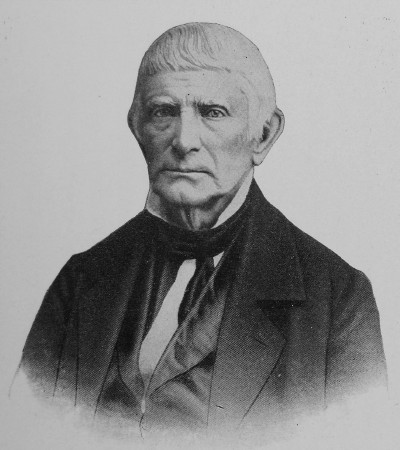 |
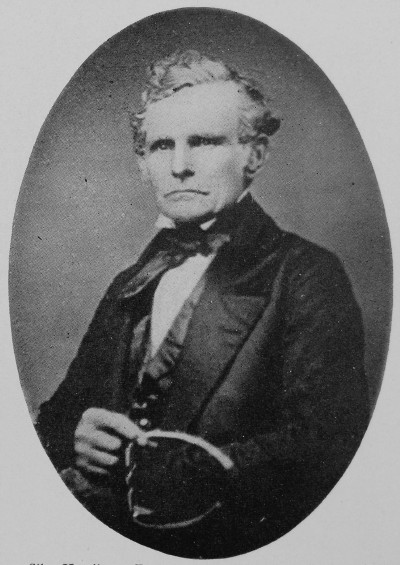 |
| Seth Thomas. From a steel engraving in "The History of Litchfield County." |
Silas Hoadley. From a portrait owned by Carleton E. Hoadley, Esq., New Haven, Conn. |
By 1809 the business was the largest in the country. In 1810 Terry sold out to two of his employees, Seth Thomas and Silas Hoadley, and removed to Plymouth Hollow.
By this time the price for the ordinary wooden clock works had dropped to $10 and finally to $5, and Terry began to cast about for a new line.
Most of the clocks of that day were either eight- day brass clocks or thirty-hour wooden clocks, with pendulums beating the seconds. A few thirty-hour brass clocks were made with a shorter pendulum, beating half seconds. These were fairly expensive, and because they were adapted to short cases were called shelf clocks.
While at work on his three-year contract, Terry conceived the idea of a thirty-hour wooden clock with half-seconds pendulum, which would be much cheaper than the brass shelf clocks. He made several hundred of these clocks without dials, but with the figures painted on the glass front.
But Terry was not satisfied with this clock and discontinued its manufacture after a year. It was not until 1814 that he perfected a shelf clock to his satisfaction. The new movement included several radically new inventions making for economy of space. It revolutionized the clock-making industry and sounded the knell of the more costly brass shelf clocks. The new type of works was not patented. It was taken up rapidly by other makers and remained in vogue for twenty-five years until the use of sheet metal came in about 1837.
In connection with the new movement Terry introduced in 1814 his "pillar and scroll-top case," which he patented. It was a rectangular case, about twenty-five inches high, with small feet and a top cut in a scroll pattern. At the sides of the front were small round pillars, twenty-one inches long, three-fourths of an inch in diameter at the bottom and three-eighths at the top, resting on a square base and surmounted by a turned cap. The dial was about eleven inches across, with a panel below painted on glass. Spandrels were painted at the corners of the face.
This clock became at once immensely popular. Seth Thomas paid $1,000 for the right to manufacture it, and he and Terry each made about $6,000 the first year. Later the output was doubled. The retail price was $15 each.
In addition to this clock, Terry made other mantel clocks, both plain and elegant. He also made brass works, adjusted with extreme care, which he sold as regulators to watchmakers for $100 to $200 each.
 |
 |
| Tall clock made by Eli Terry in 1794. Now owned by Mr. A. C. Bunnell, Ridley Park, Pa. |
An early tall clock with wooden works made by Terry. Owned by Mrs. James W. Cook of Providence |
Tower clocks were also part of his trade. These were of excellent quality, as a rule, and were affected as little as possible by the weather. Most of them were operated by separate sets of weights for chronometer, dial wheels, and striker. The clock which is still telling time from the gable of the Congregational Church in Terryville is said to have been the first of Terry's tower clocks. It was a gift to the church, which was built in 1835.
Another tower clock was built by Terry for the city of New Haven. It was placed in the Centre Church on the Green. It told the mean time while the Yale College clock told apparent time. This led to confusion and a lively controversy.
In 1830 Terry invented a new form of gravity escapement, and he continued active as an inventor and designer the rest of his life. It is not too much to say of him that this shrewd, ingenious Yankee did as much toward the advancement of clockmaking as any other one man in history. At least, he was the father of the modern cheap clock which Seth Thomas did so much to popularize.
In 1838 and 1839 Terry built two houses in that portion of Plymouth which later became known as Terryville. In one of these he lived until his death, which occurred on February 24, 1852, at the age of eighty.
In 1814, when Terry started his big contract he took two of his sons in with him and taught them the trade. Henry continued the business at Ply mouth Hollow until about 1840, when he turned to the manufacture of woolen goods. The other son, Eli, Jr., started a shop of his own in 1826, when he was twenty-five, and became the wealthy and honored founder of Terryville. A third son, Silas, was less successful in a business way, but was nearly as great an inventor as his father.
Seth Thomas, who was even more of a self-made man than Eli Terry, was born at Wolcott, Connecticut, August 19, 1785, the son of James and Martha Thomas. His education was limited to the meager advantages of the district school, and while still a youth he served his apprenticeship as carpenter and joiner. For a time he worked on the construction of the long wharf at New Haven.
When he became of age he returned to Litchfield County with his kit of tools and a small sum of money. He soon found work as a joiner in Eli Terry's factory, making clock cases and later assembling wooden works. By 1808 he had risen to the position of foreman of the case shop.
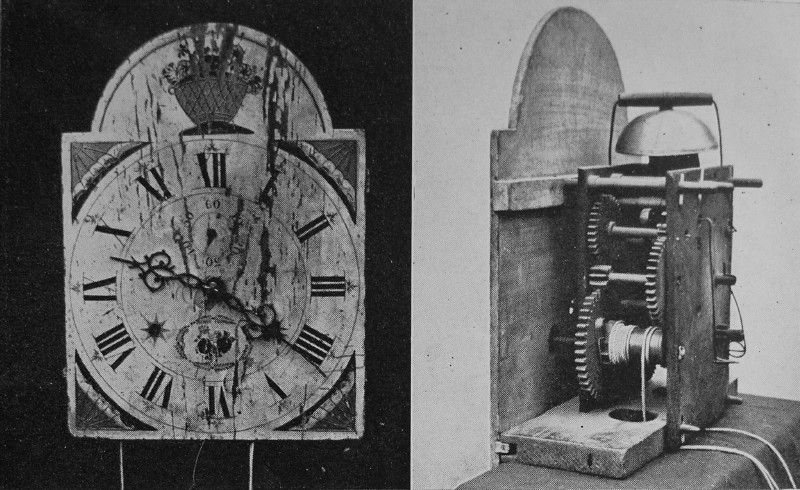 |
| Face and works of an early wooden clock by Eli Terry |
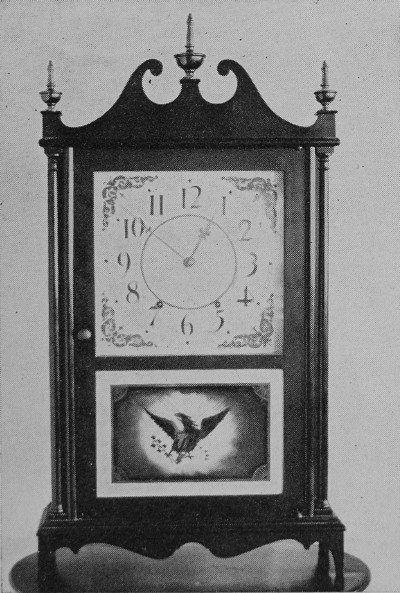 |
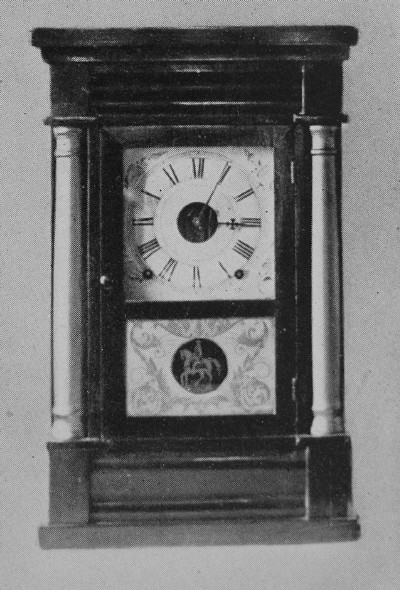 |
| A good example of the pillar-and-scroll-top style made by both Terry and Thomas |
A later type of shelf clock made by Seth Thomas. Owned by Mr. L. A. Klein, Ridley Park, Pa |
Prior to this time clockmaking had been an individual trade, like that of the village cobbler. In 1810, after buying out Terry's interest, Thomas & Hoadley continued in the manufacture of tall clocks. In 1812 or 1813 Hoadley bought Thomas out and the latter moved to Plymouth Hollow, in the western part of the town, and engaged in the manufacture of brass-movement clocks on his own account. This business grew from twenty to nine hundred operatives, and in 1853 Thomas, having made a for tune, incorporated the Seth Thomas Clock Company which is to-day doing a world-wide business. He also built a cotton mill and a brass rolling and wire mill.
Seth Thomas was a solid, Puritanical character, a staunch Whig, and a prominent member of the Congregational Church. He was twice married — to Philena Tuttle on April 20, 1808, who died March 12, 1810, and to Laura Andrews on April 14, 1811, who survived him. He was the father of nine children, three of whom died in childhood.
Seth Thomas died at Plymouth Hollow on January 29, 1859. Shortly after, that portion of the town was named Thomaston by act of Legislature.
The business was incorporated, with his sons, Aaron and Seth, Jr., as officers. They enlarged the factory and broadened the business. Later the factory, under the guidance of Seth E. Thomas, son of Seth Thomas, Jr., made every kind of timepiece from a watch to a tower clock, and sent them all over the world.
Silas Hoadley was born at Bethany, Connecticut, on January 31, 1786. Like Thomas, his education was meager and he was bound out at an early age as apprentice to his uncle, Calvin Hoadley, who taught him the trade of carpenter, which he followed till 1809, when he entered the Terry shop as a joiner.
After the final dissolution of the partnership in 1814, Hoadley continued the works at Greystone, Plymouth, until about 1849. He made both mantel and tall clocks, the former in limited quantities, apparently. His tall clock cases, while not as ornamental as those of some other clockmakers, were al ways tasteful and well proportioned, and compare favorably with anything Terry or Thomas ever did. In spite of the fact that he was in business for him self for some thirty-five years, his clocks to-day are very rare.
Though not possessing the inventive genius of Terry and Thomas, Hoadley was a good businessman and prospered. He was a prominent citizen of the town, an active Episcopalian churchman, and a high Mason. He was a Democrat and was three times elected to the State Assembly and once, in 1844, to the State Senate. He died at Plymouth December 28, 1870, leaving five children.
Another important figure in the Connecticut clock industry, though the years of his chief activity ex tend well into the nineteenth century, was Chauncey Jerome. In 1860 he published the story of his own life, in connection with his "History of the American Clock Business," and an interesting story it is.
He, too, was a lad of small schooling but marked native ability. He was born at Canaan, Connecticut, June 10, 1793, the son of a poor farmer and black smith and one of six children. In 1797 the family moved to Plymouth, where the father set up a black smith shop and engaged in the manufacture of hand-wrought iron nails. Until he was nine years old Chauncey worked on the farm, with the exception of three months in the winter, when he went to school. Then he went to work in his father's shop until the latter's death in 1804.
From then until he was fourteen young Chauncey worked for different farmers and suffered many hardships. In 1807 he was bound out to a carpenter until he was twenty-one, working for his board and clothes.
He became fascinated with the idea of learning the clockmaking trade, but his guardian would not permit it, saying that Terry was a visionary fool. But Chauncey persisted and in 1811 made a bargain with his master, whereby he was allowed to have four months to himself each winter if he would buy all his own clothes.
The first winter he went to Waterbury to work for one Lewis Stebbins, who taught him the art of making dials and clock cases. The following winter he was engaged by a Plymouth clockmaker named Hotchkiss to go to New Jersey to make cases for works that Hotchkiss had previously sold there. Two peddlers went with him to sell more works. It was a wonderful journey, made in a lumber wagon, and the venture was reasonably successful.
Jerome volunteered for service in the War of 1812, and after that, for several years, experienced the privations of poverty. At the age of twenty-one he became his own master and secured work at wages of $20 a month, on which he married. It was in that year that he bought his first pair of boots. Hard times continued until 1816, When he went to work for Eli Terry, making the new shelf clocks. Terry began to install circular saws and other machinery, and Jerome learned to use these in the making of clock cases.
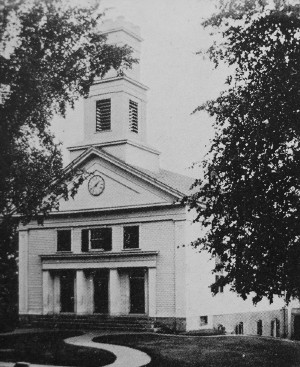
|
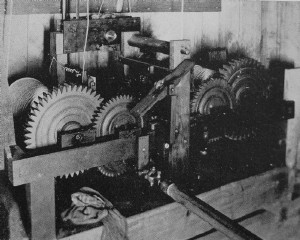 |
| Congregational Church, Terryville, Conn. The clock was made by Eli Terry in 1835 |
The original works, with their wooden wheels, remain in the Terryville church clock, but are now regulated by an electrical connection |
In 1818 Jerome started in business for himself in a small way, buying clock works in Plymouth and making mahogany cases for them. An order came at last from the South for a number of clocks at $12 each, and Jerome delivered them himself. This was the turning point in his fortunes, and in 1821 he was able to move to Bristol and set up a new business. In 1822 he engaged a clockmaker — Chauncey Board man — to make brass works for him, and in 1824 he formed, with Nobles Jerome and Elijah Darrow, the firm of Jeromes & Darrow. In this year he exported the first clock sent from this country to England.
Success followed, but Jerome's later history scarcely belongs within the period of old clocks, which ended about 1837. He introduced new machinery and cheapened the cost of manufacture until he was able to make clocks for $2 and even $1. In 1844 he moved to New Haven, where his concern made 600 clocks a day, or 200,000 a year. His retirement followed, then the loss of money by his partners, and a new start in life at the age of seventy as superintendent of a Chicago factory. Jerome's life displays remarkable evidences of strict integrity and Spartan courage.
Besides those clockmakers whose names have been. mentioned, there were others at work in Connecticut who are entitled at least to passing notice. Isaac Doolittle, a clockmaker, lived in New Haven from 1748 to 1810. In Hartford, Enos Doolittle was making clocks about 1772, including some very handsome ones in cherry cases, with dials and hoods more elaborate than those of Terry or Thomas. In 1783 a patent was issued to Benjamin Hanks of Litchfield for a self-winding clock. Silas Merriam and Timothy Peck of Litchfield were at work about 1790, and Benjamin Cheney in Manchester about 1780. James Harrison was a successful clockmaker at Waterbury; he sold his first clock in 1791 for about $16.50. In Bristol, Joseph, Chauncey, and Lawson Ives were contemporary with Jerome; Joseph invented an eight-day brass clock about 1818, which Lawson later manufactured for about $20. Other prominent Connecticut clockmakers of the early nineteenth century were Joseph Clark of Dan bury, Heman Clark of Plymouth Hollow, Daniel Clark of Waterbury, Asa Hopkins of Litchfield, who invented several improvements in clock-making machinery, and others.
There was something solid and admirable in the characters of this group of old Yankees that makes them good to consider. They represent so completely the sterling traits of their period and give us such a clear idea of the sort of men that built up the early industries of this country. And apparently their thrift and mechanical ingenuity did not exclude all feeling for the beautiful, for some of their designs are not without artistic merit, and all are quaintly original.
Clocks of all these makers are still to be found, but those of Terry and Thomas are the most numerous. The old wooden works are apt to be somewhat the worse for wear and are often quite useless, but the old cases are a joy to the collector.
The collector's chief concern should be to learn which clocks originally contained wooden and which brass works. A brass movement in a clock originally intended for wooden works naturally indicates a more or less recent substitution. An old clock with wooden works that still tells the time is indeed a treasure.
The old tall clocks are the rarest and most valuable. They may be worth from $100 to $350, according to condition and the quality and design of dials and cases, which vary widely. Terry and Thomas clocks are worth very nearly what they brought when new. One New York dealer who specializes in American antiques has made a business of collecting Terry shelf clocks, which he repairs and refinishes, putting in new brass works, and sells at a flat price of $35 each. Other wall and shelf clocks are worth, under ordinary conditions, from $15 to $40.
|
|
This home on Pequot Avenue,
Southport, Connecticut is a recently restored example of the Northrop Brothers
fine carpentry and building in the Southport-Greeens Farms area.
Image Courtesy of
David Parker Associates
|

 Son Frederick Elmore Northrop maybe about 1899
Son Frederick Elmore Northrop maybe about 1899 
 Son Frederick Elmore Northrop maybe about 1899
Son Frederick Elmore Northrop maybe about 1899 


